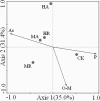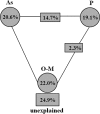Microbial communities and functional genes associated with soil arsenic contamination and the rhizosphere of the arsenic-hyperaccumulating plant Pteris vittata L
- PMID: 20833780
- PMCID: PMC2976218
- DOI: 10.1128/AEM.00500-10
Microbial communities and functional genes associated with soil arsenic contamination and the rhizosphere of the arsenic-hyperaccumulating plant Pteris vittata L
Abstract
To understand how microbial communities and functional genes respond to arsenic contamination in the rhizosphere of Pteris vittata, five soil samples with different arsenic contamination levels were collected from the rhizosphere of P. vittata and nonrhizosphere areas and investigated by Biolog, geochemical, and functional gene microarray (GeoChip 3.0) analyses. Biolog analysis revealed that the uncontaminated soil harbored the greatest diversity of sole-carbon utilization abilities and that arsenic contamination decreased the metabolic diversity, while rhizosphere soils had higher metabolic diversities than did the nonrhizosphere soils. GeoChip 3.0 analysis showed low proportions of overlapping genes across the five soil samples (16.52% to 45.75%). The uncontaminated soil had a higher heterogeneity and more unique genes (48.09%) than did the arsenic-contaminated soils. Arsenic resistance, sulfur reduction, phosphorus utilization, and denitrification genes were remarkably distinct between P. vittata rhizosphere and nonrhizosphere soils, which provides evidence for a strong linkage among the level of arsenic contamination, the rhizosphere, and the functional gene distribution. Canonical correspondence analysis (CCA) revealed that arsenic is the main driver in reducing the soil functional gene diversity; however, organic matter and phosphorus also have significant effects on the soil microbial community structure. The results implied that rhizobacteria play an important role during soil arsenic uptake and hyperaccumulation processes of P. vittata.
Figures




Similar articles
-
Rhizosphere Microbiome-Root Exudate Synergy in Pteris vittata: Coordinated Arsenic Speciation and Multielement Metabolic Coupling Drive Hyperaccumulation Efficiency.Microb Ecol. 2025 Jul 23;88(1):79. doi: 10.1007/s00248-025-02584-3. Microb Ecol. 2025. PMID: 40699244 Free PMC article.
-
Assessing the microbial community and functional genes in a vertical soil profile with long-term arsenic contamination.PLoS One. 2012;7(11):e50507. doi: 10.1371/journal.pone.0050507. Epub 2012 Nov 30. PLoS One. 2012. PMID: 23226297 Free PMC article.
-
Arsenic and phosphate rock impacted the abundance and diversity of bacterial arsenic oxidase and reductase genes in rhizosphere of As-hyperaccumulator Pteris vittata.J Hazard Mater. 2017 Jan 5;321:146-153. doi: 10.1016/j.jhazmat.2016.08.079. Epub 2016 Sep 1. J Hazard Mater. 2017. PMID: 27619960
-
Mechanisms of efficient As solubilization in soils and As accumulation by As-hyperaccumulator Pteris vittata.Environ Pollut. 2017 Aug;227:569-577. doi: 10.1016/j.envpol.2017.05.001. Epub 2017 May 11. Environ Pollut. 2017. PMID: 28501771 Review.
-
[Advances in molecular mechanisms of arsenic hyperaccumulation of Pteris vittata L.].Sheng Wu Gong Cheng Xue Bao. 2020 Mar 25;36(3):397-406. doi: 10.13345/j.cjb.190374. Sheng Wu Gong Cheng Xue Bao. 2020. PMID: 32237534 Review. Chinese.
Cited by
-
Use of functional gene arrays for elucidating in situ biodegradation.Front Microbiol. 2012 Sep 21;3:339. doi: 10.3389/fmicb.2012.00339. eCollection 2012. Front Microbiol. 2012. PMID: 23049526 Free PMC article.
-
Spatial scale affects the relative role of stochasticity versus determinism in soil bacterial communities in wheat fields across the North China Plain.Microbiome. 2018 Feb 5;6(1):27. doi: 10.1186/s40168-018-0409-4. Microbiome. 2018. PMID: 29402331 Free PMC article.
-
Bacterial community and arsenic functional genes diversity in arsenic contaminated soils from different geographic locations.PLoS One. 2017 May 5;12(5):e0176696. doi: 10.1371/journal.pone.0176696. eCollection 2017. PLoS One. 2017. PMID: 28475654 Free PMC article.
-
Rhizosphere colonization and arsenic translocation in sunflower (Helianthus annuus L.) by arsenate reducing Alcaligenes sp. strain Dhal-L.World J Microbiol Biotechnol. 2013 Oct;29(10):1931-40. doi: 10.1007/s11274-013-1359-4. Epub 2013 Apr 30. World J Microbiol Biotechnol. 2013. PMID: 23632906
-
Assessment on cadmium and lead in soil based on a rhizosphere microbial community.Toxicol Res (Camb). 2017 Jun 16;6(5):671-677. doi: 10.1039/c7tx00048k. eCollection 2017 Sep 1. Toxicol Res (Camb). 2017. PMID: 30090534 Free PMC article.
References
-
- Arai, Y., D. L. Sparks, and J. A. Davis. 2004. Effects of dissolved carbonate on arsenate adsorption and surface speciation at the hematite-water interface. Environ. Sci. Technol. 38:817-824. - PubMed
-
- Cao, X., L. Q. Ma, and A. Shiralipour. 2003. Effects of compost and phosphate amendments on arsenic mobility in soils and arsenic uptake by the hyperaccumulator, Pteris vittata L. Environ. Pollut. 126:157-167. - PubMed
-
- Cao, X., L. Q. Ma, and C. Tu. 2004. Antioxidative responses to arsenic in the arsenic-hyperaccumulator Chinese brake fern (Pteris vittata L.). Environ. Pollut. 128:317-325. - PubMed
-
- Clarke, K. R., and M. Ainsworth. 1993. A method of linking multivariate community structure to environmental variables. Mar. Ecol. Prog. Ser. 92:205-219.
Publication types
MeSH terms
Substances
LinkOut - more resources
Full Text Sources
Molecular Biology Databases

